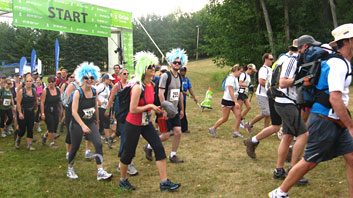Oxfam Trailwalker: The most challenging charity event ever?
Could you walk 100 km in 48 hours or less, on moderately challenging hiking trails in the middle of summer?

Could you walk 100 km in 48 hours or less, on moderately challenging hiking trails in the middle of summer?
For most of us, the answer is no’not, at least, without a lot of training. I gave it a shot this past weekend with a team of women working in media and none of us made it to the end’but we got an amazing glimpse into the hard work, dedication, energy and pain tolerance of the 400 or so people who participated in Oxfam Trailwalker Canada 2011. (That’s me in the green T-shirt at the far left of the image of the start line.)
Oxfam Canada is a branch of the International Oxfam Confederation, which works to fight poverty and injustice around the world, particularly in relation to women’s rights. Oxfam Trailwalker, which started as a military exercise in Hong Kong in 1981, is a major fundraising event taking place in 14 countries this year, and since it began has raised more than $60 million internationally. Each team must raise at least $2,500 to participate.
Oxfam Trailwalker is an endurance event, a powerful symbol of the endurance displayed every day by those living in extreme poverty around the world. Each team of four must check in and out of each of the eight checkpoints along the route together, which is important for safety and team-building reasons, and are aided by a support crew that meets them at checkpoints with food, supplies and encouragement.
Walking 100 km in such a short time period is hard, and many people don’t make it to the end. My team didn’t train as hard as we could have’busy schedules prevented us from making it to any of the official training walks, and my peak walk in the city was just 26 km’but we’re all fit runners who are accustomed to walking a lot in our daily lives. The first 25 km were fairly easy and on beautiful terrain, and we were lucky to have cloud cover on the day after southern Ontario’s extreme high-30s temperatures. But after that, things started to get more challenging, and it was the fourth section, an 8.8-km loop done in the dark that brought our total up to 48.5, that did me in. For one thing, hiking in the dark is mentally fatiguing, and my leg muscles ultimately stiffened up to the point that I was having trouble getting up and down the checkpoint stairs. I also had a few big blisters that had been expertly wrapped by athletic therapists Mike and Leslie but looked like they were likely to get worse. At that point, I decided to avoid injury by letting my teammates continue without me (groups of three are allowed to continue, but no smaller) and joined the support team.
My teammates completed three more sections up to a total of 82.2 km, but at that point they were done, due to a combination of swollen knees, tight muscles, exhaustion, lots of blisters and a nasty case of poison ivy. We weren’t the worst off in the first aid tents’one medic said this year was especially bad because of the high heat and humidity levels’but none of us was in great shape either (though after 12 hours of rest I was feeling much better). A little disappointed but happy with what we had achieved, and full of admiration for all the walkers who were giving the event all they had, we left to return to the city and some well-deserved showers and naps.
Would I do it again? Hard to say. 50 km, yes. 100? Only if I had the time in my life for very thorough training, perhaps including a year or more of regular long hikes. But next time someone approaches me asking for sponsorship for their own participation in Trailwalker, I’ll give gladly. Not only is the cause deserving, but the dedication required of its participants more than worthy of support.
Would you walk 100 km to fight poverty? What do you think of this event?
Related:
‘ 4 Canadian yoga adventures
‘ How to prepare for a charity walk
‘ 4 ways to burn more calories when walking




